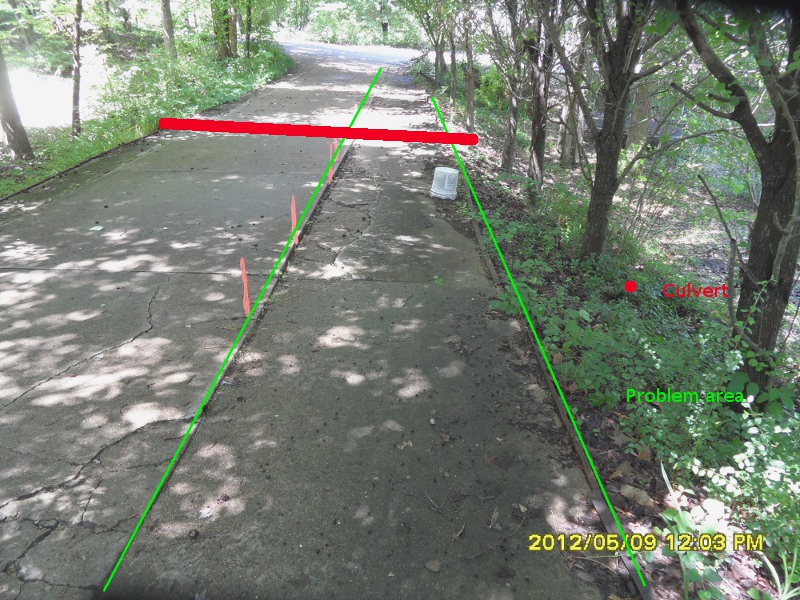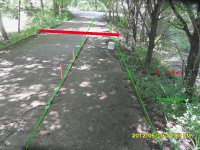newbury
Super Star Member
- Joined
- Jan 8, 2009
- Messages
- 13,590
- Location
- From Vt, in Va, retiring to MS
- Tractor
- Kubota's - B7610, M4700
At the house we bought in Mississippi there is a concrete driveway crossing a culvert leading up to the house. It had been widened and where it was widened it looks like they did not put down sufficient stabilizing base. And it is cracking and slumping on the "addition" (between the green lines).

It's about 100' long with a small culvert under it about where the red line is.
The side portion ranges from 3' at the far end to 5' at the near end.
I had figured it was going to be a tear out and replace with associated $$$$$.
I called a respected contractor out for an estimate. He gave an "off the top" of his head guesstimate of about $8K plus, perhaps ripping out old and putting down a new base
But he then proceeded to tell me that they could probably repair OVER the cracked section for significantly less by putting some mesh and a patch concrete down.
And then he proceeded to tell me I could probably do it myself for the cost of the patch concrete and mesh.
In the hazy past I'd done a lot of concrete mixing for building a house using a mixer. More recently I've done it in my FEL. So I feel up to the task of doing pours of concrete. But if I'm pouring concrete 1" thick x 100' x 4' it will take about 75 bags of QUIKRETE 60 Lb. Sand/Topping Mix at $5@. I know I need a mixer.
So I seem to be looking at an exercise opportunity (no need for gym fees!) for $<1,000 (w/ all cost including a mixer) or sit in a recliner and have someone else do the whole shebang for a heck of a lot more.
If need be I can dig up the old concrete, but if I can leave it there it would be easier.
So my questions for the forum:
What more info is needed?
What's the best way to tell if a "patch over solution" will work?
How thick can the said mix be used (I read for regular concrete it should be 2" or thicker, for the "patch" < 2")
Is there a better type of concrete?
What are suggestions for bank stabilization? Should I put down railroad ties? Rip-Rap? Should I pound in posts?
Any recommendations on small cement mixers? I can see a need for other future projects (including boots for some people).
All good suggestions welcome. Poor suggestions also expected.
I plan on building forms from my own timber, I've my tractor and backhoe available.
It's about 100' long with a small culvert under it about where the red line is.
The side portion ranges from 3' at the far end to 5' at the near end.
I had figured it was going to be a tear out and replace with associated $$$$$.
I called a respected contractor out for an estimate. He gave an "off the top" of his head guesstimate of about $8K plus, perhaps ripping out old and putting down a new base
But he then proceeded to tell me that they could probably repair OVER the cracked section for significantly less by putting some mesh and a patch concrete down.
And then he proceeded to tell me I could probably do it myself for the cost of the patch concrete and mesh.
In the hazy past I'd done a lot of concrete mixing for building a house using a mixer. More recently I've done it in my FEL. So I feel up to the task of doing pours of concrete. But if I'm pouring concrete 1" thick x 100' x 4' it will take about 75 bags of QUIKRETE 60 Lb. Sand/Topping Mix at $5@. I know I need a mixer.
So I seem to be looking at an exercise opportunity (no need for gym fees!) for $<1,000 (w/ all cost including a mixer) or sit in a recliner and have someone else do the whole shebang for a heck of a lot more.
If need be I can dig up the old concrete, but if I can leave it there it would be easier.
So my questions for the forum:
What more info is needed?
What's the best way to tell if a "patch over solution" will work?
How thick can the said mix be used (I read for regular concrete it should be 2" or thicker, for the "patch" < 2")
Is there a better type of concrete?
What are suggestions for bank stabilization? Should I put down railroad ties? Rip-Rap? Should I pound in posts?
Any recommendations on small cement mixers? I can see a need for other future projects (including boots for some people).
All good suggestions welcome. Poor suggestions also expected.
I plan on building forms from my own timber, I've my tractor and backhoe available.
